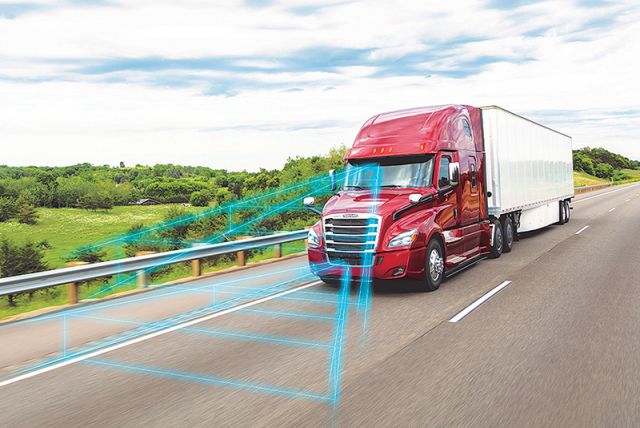Industry-First Safety Features from Detroit Assurance Contribute to Safer Roads, Driver Comfort

DETROIT, MI… Detroit has added new features to the Detroit Assurance suite of safety systems including enhanced and industry-first capabilities designed to improve the overall driver experience and keep drivers and the general public safer.
“We are focused on manufacturing the best trucks in the industry, and our customers tell us that there is nothing more critical than the safety features included in our Freightliner and Western Star trucks,” said David Carson, senior vice president of sales and marketing, Daimler Trucks North America. “The ongoing evolution of our Detroit Assurance offerings is based on our unwavering commitment to developing purposeful technologies and solutions that will help protect truck drivers, other motorists and pedestrians.”
Available for the Freightliner Cascadia and the Western Star 49X spec’d with a Detroit powertrain, the new Detroit Assurance features reduce driver strain and fatigue and can help reduce speed-related accidents. The features are:
* Active Speed Intervention (ASI): If the truck exceeds the posted speed limit, ASI issues visual and auditory warnings to actively alert the driver. Once the warning is issued and depending on how far above the truck is over the speed limit, ASI will go into effect and de-throttle the engine for two seconds, adjust Adaptive Cruise Control (ACC) to the posted speed limit, or cancel ACC. In addition to helping remind drivers of posted speed limits, ASI can be a valuable training aid for fleet managers to help drivers reduce the risk of speed-related accidents. ASI is useful on trucks that routinely travel in and out of various speed zones throughout the day.
* Active Lane Assist (ALA) with Auto Stop: Exclusively available with the Freightliner Cascadia, ALA with Auto Stop actively brakes the truck to a safe stop rather than letting the truck roll to a stop in case of an incapacitated driver or if the driver’s hands are off the steering wheel for more than 60 seconds, which can help protect the driver as well as other vehicles on the road. When ALA’s Auto Stop function activates, Lane Keep Assist (LKA) keeps the truck centered in its lane while the truck safely and gradually brakes, all the way down to 0 mph, further contributing to ALA’s effectiveness and safety. After coming to a stop, the vehicle doors automatically un-lock and the interior lights flash in an S.O.S sequence, alerting other motorists that assistance is required.
* Brake Hold Mode: After coming to a stop, the driver further presses the brake pedal to activate the Brake Hold Mode function, reducing the need for the driver to continually press the brake pedal down in prolonged periods of standstill. The brake will not get deactivated if the driver’s foot is removed from the brake pedal due to fatigue or slippage. Tapping the brake pedal or pressing the accelerator starts moving the truck again. This is particularly driver friendly in work environments that involve waiting periods in the truck while at a standstill, such as at weigh scales and in heavy traffic.
“By providing drivers with tools such as Detroit Assurance, we help mitigate potential accidents, as well alleviate driver fatigue and strain, which will help drivers stay more aware and make their jobs a little bit easier,” said Carson.
The advantages to these advanced safety features are amplified by the full Detroit Assurance suite of safety systems, which includes access to the Detroit Connect portal. Detroit Connect provides fleets access to critical information on the performance of their vehicles such as vehicle location, fault codes, diagnostics and fuel performance. Detroit Connect also offers valuable safety insights into driver behavior and safety critical information when Detroit Assurance features are activated, such as providing a detailed event report when Active Lane Assist with Auto Stop brings the vehicle to a complete stop. With this information, fleets can intervene to help their drivers that require immediate assistance.
